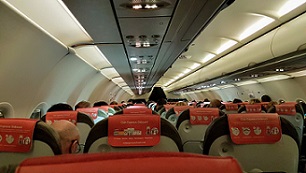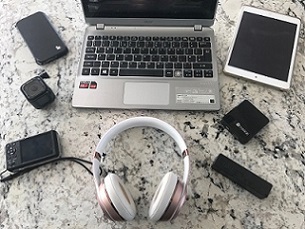 The last place you want a lithium battery fire is in the confined space of an aircraft passenger cabin
The last place you want a lithium battery fire is in the confined space of an aircraft passenger cabin
 All these personal electronic devices are powered by lithium batteries
All these personal electronic devices are powered by lithium batteries
 A pilot with an award-winning AvSax lithium battery fire mitigation bag
A pilot with an award-winning AvSax lithium battery fire mitigation bag
A new warning has become part of the usual pre-flight safety briefing by cabin crew before any passenger plane takes off … and this is why it’s such a strict one.
The crew now say that if your personal electronic device such as a laptop, mobile phone or a battery charger slips down into the seat mechanism or starts to feel like it’s overheating and may catch fire then it’s vital they are alerted immediately.
Ryanair crew say this: “If your device or its battery is damaged, hot, produces smoke, is lost or falls into the seat structure then please inform the cabin crew immediately.”
The reason is that all these devices are powered by lithium ion batteries and if the battery becomes crushed or damaged any other way it could go into what’s known as thermal runaway.
When this happens one cell in a battery overheats it can produce enough heat – up to 900°C (1652°F) – to cause adjacent cells to overheat. This can cause a lithium battery fire to flare repeatedly and, because they burn at such a high temperature, they are very difficult to put out.
If this happens in a seat the fire burns with such intensity the blaze could quickly spread with potentially catastrophic results.
This is the reason why an aircraft did a U-turn over the Atlantic on May 19, 2024, when a passenger lost his laptop in his seat and it became jammed in there.
The captain on the United Airlines flight from Zurich in Switzerland to Chicago in the USA didn’t want to take the risk that the laptop had become damaged and could suddenly catch fire over the ocean so flew 500 miles back to Ireland and did an emergency landing at Shannon Airport.
Once there engineers freed the laptop but the crew would be over their flying hours to continue the journey so the passengers were delayed in Ireland for 24 hours.
In 2021 it was revealed that mobile phones crushed after being lost down aircraft seats had sparked more than 40 fires on planes in the previous five years and continue to be a ‘significant hazard’ in the future.
The statistics, collated by the UK’s aviation regulator the Civil Aviation Authority, were revealed in an official report into a fire on board a British Airways Dreamliner caused by a mobile phone being damaged by a seat.
The Air Accidents Investigation Branch report (AAIB) states: “The CAA has received 166 reports of personal electronic devices lost in passenger seats in the last five years. A quarter of these events resulted in fire or smoke in the cabin, demonstrating that this is a significant hazard to the safety of the aircraft.”
Although airline manufacturers are trying to improve seat design to stop these kind of lithium-ion battery crush incidents from happening, it is proving to be a challenge and there are currently no seat design requirements to prevent electronic devices from becoming trapped in seats.
The fire on the British Airways flight happened when the Dreamliner was flying from Miami to London Heathrow on October 1, 2020. It was 40 minutes from landing when a passenger moved her seat from the bed position to an upright one before going to the toilet.
The flight crew quickly smelled a strong odour of sulphur, heard a hissing sound and then a large plume of smoke came from the seat in what they described as a ‘tornado’. The crew also saw an orange glow in the seat area among the smoke
They pulled the seat padding back and saw a mobile phone trapped in the seat mechanism and doused the phone with several bursts from a dry powder fire extinguisher as they feared using water could cause further problems as the seat’s mechanism was electrically-powered.
The red phone was hopelessly jammed in the mechanism. The pilots decided to continue the descent into Heathrow and a cabin crew member sat next to the phone with the fire extinguisher in case it flared up again. The phone was eventually removed by the fire service when the plane landed.
The investigation revealed that when the chair was adjusted by the passenger it crushed and badly damaged the phone’s battery, causing smoke, flames and fumes.
Many airlines are now equipped with an award-winning British invention, the AvSax lithium battery fire mitigation bag, so they are prepared to deal with a lithium battery incident on board any passenger aircraft.
AvSax are designed to continually cool an overheating battery but are made from military grade material so should the battery explode it will be contained within the bag. In every incident where an AvSax has been deployed the aircraft has been able to continue to its final scheduled destination, avoiding the need for a disruptive and costly diversion and emergency landing.
AvSax are now on board around 16,750 aircraft operated by more than 100 airline companies worldwide, including some of the best-known names in the aviation industry.
AvSax won the Queen’s Award for Enterprise in the UK for their innovation and were devised by Environmental Defence Systems Ltd based in Huddersfield, Yorkshire, England. The Queen’s Award is the highest accolade any business can get.
For more information on AvSax go to www.avsax.com